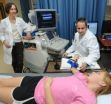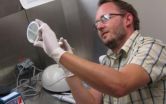(Press-News.org) The number of prescription drugs that can have serious adverse effects from interactions with grapefruit are markedly increasing, yet many physicians may be unaware of these effects, states an article published in CMAJ (Canadian Medical Association Journal). The article, a review by the researchers who discovered the interactions more than 20 years ago, summarizes evidence to help clinicians better understand the serious effects this common food can have when consumed with certain prescription drugs.
"Many of the drugs that interact with grapefruit are highly prescribed and are essential for the treatment of important or common medical conditions," writes Dr. David Bailey, Lawson Health Research Institute, London, Ont., with coauthors. "Recently, however, a disturbing trend has been seen. Between 2008 and 2012, the number of medications with the potential to interact with grapefruit and cause serious adverse effects…has increased from 17 to 43, representing an average rate of increase exceeding 6 drugs per year. This increase is a result of the introduction of new chemical entities and formulations."
Adverse effects include sudden death, acute kidney failure, respiratory failure, gastrointestinal bleeding, bone marrow suppression in immunocompromised people, renal toxicity and other serious side effects.
"Unless health care professionals are aware of the possibility that the adverse event they are seeing might have an origin in the recent addition of grapefruit to the patient's diet, it is very unlikely that they will investigate it," write the authors. "In addition, the patient may not volunteer this information. Thus, we contend that there remains a lack of knowledge about this interaction in the general healthcare community."
There are more than 85 drugs that may interact with grapefruit, and 43 can have serious side effects. Other citrus fruits such as Seville oranges, often used in marmalade, limes and pomelos also contain the active ingredients (furanocoumarins). These chemicals are innate to the fruit and cause the interaction by irreversible inhibition of the drug metabolizing CYP3A4 enzyme that normally inactivates the effects of an estimated 50% of all medication. Drugs that interact with these chemicals have three characteristics: they are administered orally, they have very low to intermediate bioavailability (percentage of the oral dose of drug absorbed into the blood circulation unchanged) and they undergo drug metabolism in the gastrointestinal tract by CYP3A4. For drugs with very low bioavailability, ingestion of a single normal amount of grapefruit can be analogous to consuming multiple doses of the drug alone.
This interaction can occur even if grapefruit is consumed many hours before taking the medication. Thus, a modest solitary quantity of grapefruit can affect interacting drugs that are taken once a day at any time during the dosing interval. Frequent daily consumption of a regular amount can further augment the effect. For example, simvastatin, a commonly used statin, combined with a 200-mL glass of grapefruit juice once a day for 3 days, produced a 330% systemic concentration of the drug compared with water.
People older than 45 years are the prime purchasers of grapefruit and receive the most prescriptions for drugs. Because of the size of this population, substantial exposure to this interaction is likely. As well, older adults can have decreased ability to tolerate excessive systemic drug concentrations. Consequently, older people are especially vulnerable to these interactions.
"The current trend of increasing numbers of newly marketed grapefruit-affected drugs possessing substantial adverse clinical effects necessitates an understanding of this interaction and the application of this knowledge for the safe and effective use of drugs in general practice," conclude the authors.
### END
Grapefruit–medication interactions increasing
2012-11-26
ELSE PRESS RELEASES FROM THIS DATE:
Risk of hemorrhage from warfarin higher in clinical practice than clinical trials show
2012-11-26
Rates of hemorrhage for older patients on warfarin therapy are much higher than rates reported in clinical trials, found a study published in CMAJ (Canadian Medical Association Journal).
"The rate of hemorrhage in our study is considerably higher than those reported in randomized controlled trials of warfarin therapy, which have ranged between 1% and 3% per person-year," writes lead author Tara Gomes, Institute for Clinical Evaluative Sciences (ICES), Toronto, with coauthors.
Warfarin, a commonly used blood thinner, is used to treat patients with atrial fibrillation ...
Federal government and big pharma seen as increasingly diminished source of research funding
2012-11-26
In a commentary to be published in the Dec. 12 issue of The Journal of the American Medical Association, two Johns Hopkins faculty members predict an ever-diminishing role for government and drug company funding of basic biomedical research and suggest scientists look to "innovative" kinds of private investment for future resources. Current negotiations in Washington over sequestration and the so-called "fiscal cliff" provide an opportunity to fundamentally rethink the funding of biomedical research, they say.
Pointing to a decade of flat government funding for biomedical ...
Researchers identify cause of anethesia-associated seizures
2012-11-26
Antifibrinolytic drugs are frequently used to prevent blood loss during surgery, but sometimes cause convulsive seizures. In this issue of the Journal of Clinical Investigation, researchers led by Beverly Orser at the University of Toronto investigated the molecular mechanisms that underlie this side effect. By studying antifibrinolytics in mice, Orser and colleagues found that the drugs inhibited the activity of glycine receptors in the brain, leading to seizures. Seizures could be prevented by co-treatment with the general anesthetic isoflurane. This study explains the ...
Bariatric surgical procedures have similar therapeutic benefits in obese adults
2012-11-26
Obesity is associated with insulin resistance and type 2 diabetes, both of which can be significantly improved by weight loss. Gastric bypass and adjustable gastric banding are two bariatric surgery techniques that are frequently used to effect weight loss in obese patients, but it is unclear if the two procedures produce different outcomes. In this issue of the Journal of Clinical Investigation, researchers led by Samuel Klein at the University of Washington School of Medicine in St. Louis compared the effects of 20% weight loss induced by either gastric bypass or adjustable ...
JCI early table of contents for Nov. 26, 2012
2012-11-26
Bariatric surgery procedures have similar therapeutic benefits in obese adults
Obesity is associated with insulin resistance and type 2 diabetes, both of which can be significantly improved by weight loss. Gastric bypass and adjustable gastric banding are two bariatric surgery techniques that are frequently used to effect weight loss in obese patients, but it is unclear if the two procedures produce different outcomes. In this issue of the Journal of Clinical Investigation, researchers led by Samuel Klein at the University of Washington School of Medicine in St. Louis ...
Old habits die hard: Helping cancer patients stop smoking
2012-11-26
ANN ARBOR—It's a sad but familiar scene near the grounds of many medical campuses: hospital-gowned patients, some toting rolling IV poles, huddled in clumps under bus shelters or warming areas, smoking cigarettes.
Smoking causes 30 percent of all cancer deaths and 87 percent of all lung cancer deaths. Yet, roughly 50 percent to 83 percent of cancer patients keep smoking after a cancer diagnosis, through treatment and beyond, says Sonia Duffy, University of Michigan School of Nursing researcher. For patients who quit on their own, relapse rates (as in the general population) ...
Corporate wrongdoers should stick to the facts in post-crisis message
2012-11-26
When faced with scandal or wrongdoing, corporations should stick to the facts in their post-crisis messaging, according to a new study from researchers at Rice University, the University of Georgia and the University of Maryland – College Park.
The study, "Managing the message: The effects of firm actions and industry spillovers on media coverage following wrongdoing," examined quarterly media coverage of 45 U.S. public toy companies a 10-year period and over 5,500 press releases generated by the companies during that time.
Almost half of the companies surveyed conducted ...
Risk aversity visible in the brain
2012-11-26
Some people live their lives by the motto "no risk - no fun!" and avoid hardly any risks. Others are clearly more cautious and focus primarily on safety when investing and for other business activities. Scientists from the University of Bonn in cooperation with colleagues from the University of Zurich studied the attitudes towards risk in a group of 56 subjects. They found that in people who preferred safety, certain regions of the brain show a higher level of activation when they are confronted with quite unforeseeable situations. In addition, they do not distinguish as ...
Impaired blood vessel function found in cystic fibrosis patients
2012-11-26
AUGUSTA, Ga. – The first evidence of blood vessel dysfunction has been found in a small cohort of generally healthy young people with cystic fibrosis, researchers report.
"Even though the lung function in these kids is fine at this point, there is evidence of vascular dysfunction and exercise intolerance," said Dr. Ryan A. Harris, clinical exercise physiologist at the Medical College of Georgia and Institute of Public and Preventive Health at Georgia Health Sciences University. "We think this blood vessel dysfunction could be contributing to their exercise intolerance, ...
Microbial 'missing link' discovered after man impales hand on tree branch
2012-11-26
It all started with a crab apple tree.
Two years ago, a 71-year-old Indiana man impaled his hand on a branch after cutting down a dead tree. The wound caused an infection that led scientists to discover a new bacterium and solve a mystery about how bacteria came to live inside insects.
On Oct. 15, 2010, Thomas Fritz, a retired inventor, engineer and volunteer firefighter, cut down a dead, 10-foot-tall crab apple tree outside his home near Evansville, Ind.
As he dragged away the debris, he got tangled in it and fell. A small branch impaled his right hand in the fleshy ...

